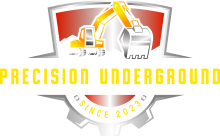Directional boring, or horizontal directional drilling (HDD), is an advanced technique for installing underground utilities with minimal surface disruption. This method allows pipes, cables, and other utilities to be installed beneath obstacles like roadways, patios, or other infrastructure without disturbing the surface above.
How Does Directional Boring Work?
HDD starts with a small pilot hole drilled at a specific angle to avoid surface interference. A drilling rig bores the hole horizontally, and as the drill progresses, it is steered in the desired direction using real-time feedback from sensors.
Once the pilot hole reaches its target, it is enlarged to the required size, and the new utility is pulled back through the hole. This technique allows for precise, controlled installation of pipelines, electrical conduits, or communication cables with minimal disturbance to the surrounding environment.
Benefits of Directional Drilling
- Minimizes Surface Disruption: One of the standout benefits of directional boring is its ability to minimize surface disruption. The underground drill avoids trenching or excavation, making it ideal for projects beneath roads or sidewalks. This method reduces the impact on the surrounding area and minimizes the need for extensive restoration work once the installation is complete.
- Ideal for Sensitive Environments: HDD is well-suited for installation projects in fragile ecosystems, wetlands, or areas with protected vegetation. The minimal surface disruption ensures that the surrounding environment remains undisturbed, preserving the natural habitat and reducing the risk of erosion or water contamination.
- Cost and Time Efficiency: Horizontal directional drilling eliminates the need for large-scale excavation, making it more cost-effective than traditional trenching methods. With less disruption to traffic or daily operations, projects can often be completed more quickly, reducing labor and material costs.
- Preserve Existing Infrastructure: With HDD, there’s no need to remove or disturb existing infrastructure like patios or utilities. This means there is less risk of damage to current systems and fewer disruptions to residents’ or businesses’ daily activities.
Streamline Your Installation With Directional Boring
HDD continues to be a preferred method for underground utility installation due to its efficiency, cost savings, and reduced environmental impact. Whether for residential or commercial projects, this technology offers a modern and practical solution for infrastructure development.
Ready to get started? Contact Precision Underground Minnesota today for a consultation or request a free quote. Our team is here to ensure your project runs smoothly from start to finish!
